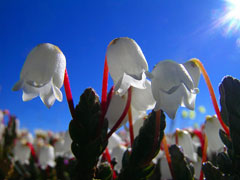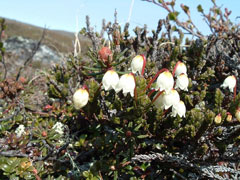 |
|
http://picasaweb.google.com/lh/photo/kqWzTgz3M2SYGYJNdmGH5w |
 |
| http://www.flickr.com/people/geologue/ |
Translate this page:
Summary
Physical Characteristics

 Cassiope tetragona is an evergreen Shrub growing to 0.3 m (1ft) by 0.2 m (0ft 8in).
Cassiope tetragona is an evergreen Shrub growing to 0.3 m (1ft) by 0.2 m (0ft 8in).
See above for USDA hardiness. It is hardy to UK zone 3. It is in leaf all year, in flower from April to May. The species is hermaphrodite (has both male and female organs) and is pollinated by Insects.
Suitable for: light (sandy) and medium (loamy) soils, prefers well-drained soil and can grow in nutritionally poor soil. Suitable pH: mildly acid, neutral and basic (mildly alkaline) soils. It can grow in semi-shade (light woodland). It prefers dry or moist soil.
UK Hardiness Map
US Hardiness Map
Synonyms
Andromeda tetragona.
Plant Habitats
Cultivated Beds;
Edible Uses
References More on Edible Uses
Medicinal Uses
Plants For A Future can not take any responsibility for any adverse effects from the use of plants. Always seek advice from a professional before using a plant medicinally.
None known
References More on Medicinal Uses
The Bookshop: Edible Plant Books
Our Latest books on Perennial Plants For Food Forests and Permaculture Gardens in paperback or digital formats.

Edible Tropical Plants
Food Forest Plants for Hotter Conditions: 250+ Plants For Tropical Food Forests & Permaculture Gardens.
More

Edible Temperate Plants
Plants for Your Food Forest: 500 Plants for Temperate Food Forests & Permaculture Gardens.
More

More Books
PFAF have eight books available in paperback and digital formats. Browse the shop for more information.
Shop Now
Other Uses
Fuel Insulation Tinder
The plant, combined with mosses and lichens, has been used as an insulation material in houses[257] The plant makes a good tinder[257]. Used for fuel[61, 257]. Considering the size of the plant (up to 30cm), this use must be born out of desperation in areas with very few woody plants[K].
Special Uses
References More on Other Uses
Cultivation details
Requires a lime-free well-drained but moistish soil and protection from bright sunlight[1, 11, 188]. Another report says that the plant tolerates some lime[200] whilst yet another report says that it is calcicole (requires a lime-rich soil)[50]. Plants seldom live long in the drier and warmer areas of the country, growing better in the west and north[182]. They prefer a colder winter than is normally experienced in S, Britain, with a covering of snow for protection and are hardy to at least -15°c[11, 200].
References Carbon Farming Information and Carbon Sequestration Information
Temperature Converter
Type a value in the Celsius field to convert the value to Fahrenheit:
Fahrenheit:
The PFAF Bookshop
Plants For A Future have a number of books available in paperback and digital form. Book titles include Edible Plants, Edible Perennials, Edible Trees,Edible Shrubs, Woodland Gardening, and Temperate Food Forest Plants. Our new book is Food Forest Plants For Hotter Conditions (Tropical and Sub-Tropical).
Shop Now
Plant Propagation
Seed - we have no details for this species but we would suggest surface-sowing sowing the seed as soon as it is ripe or in late winter in a well-drained ericaceous compost in a cold frame. Do not allow the compost to dry out. When they are large enough to handle, prick the seedlings out into individual pots and grow them on in a greenhouse for at least their first winter. Plant them out into their permanent positions in late spring or early summer, after the last expected frosts. Layering in August[78]. Alternatively, dig up the plant in early spring and replant it 10 - 20cm deeper in the soil. The buried branches will form roots and these can be divided and replanted in the autumn of the following year[200]. Cuttings of half-ripe shoots, 2 -3cm with a heel, in a shady frame in August. Do not remove the leaves or allow the cuttings to dry out. Fair percentage[78].
Other Names
If available other names are mentioned here
Native Range
TEMPERATE ASIA: Russian Federation (Amur, Kamcatskij kraj) NORTHERN AMERICA: United States (Alaska), Montana, Washington), Canada (Québec, Alberta, British Columbia) EUROPE: Finland, Iceland, Norway, Svalbard and Jan Mayen, Russian Federation-European part (European part)
Weed Potential
Right plant wrong place. We are currently updating this section.
Please note that a plant may be invasive in one area but may not in your area so it's worth checking.
Conservation Status
IUCN Red List of Threatened Plants Status :

Growth: S = slow M = medium F = fast. Soil: L = light (sandy) M = medium H = heavy (clay). pH: A = acid N = neutral B = basic (alkaline). Shade: F = full shade S = semi-shade N = no shade. Moisture: D = dry M = Moist We = wet Wa = water.
Now available:
Food Forest Plants for Mediterranean Conditions
350+ Perennial Plants For Mediterranean and Drier Food Forests and Permaculture Gardens.
[Paperback and eBook]
This is the third in Plants For A Future's series of plant guides for food forests tailored to
specific climate zones. Following volumes on temperate and tropical ecosystems, this book focuses
on species suited to Mediterranean conditions—regions with hot, dry summers and cool, wet winters,
often facing the added challenge of climate change.
Read More
Expert comment
Author
(L.)D.Don.
Botanical References
1150200
Links / References
For a list of references used on this page please go here
Readers comment
| Add a comment |
|
If you have important information about this plant that may help other users please add a comment or link below. Only comments or links that are felt to be directly relevant to a plant will be included. If you think a comment/link or information contained on this page is inaccurate or misleading we would welcome your feedback at [email protected]. If you have questions about a plant please use the Forum on this website as we do not have the resources to answer questions ourselves.
* Please note: the comments by website users are not necessarily those held by PFAF and may give misleading or inaccurate information.
To leave a comment please Register or login here All comments need to be approved so will not appear immediately.
|
Subject : Cassiope tetragona
|
|
|
|